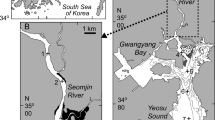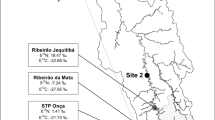Abstract
Frequency and intensity of precipitation events can alter hydrological conditions of lotic systems and material inflow from the catchment. In this study, interannual changes in food web structure were investigated in a lake–swamp–river system in the semi-arid West Siberian forest-steppe region using carbon and nitrogen stable isotope ratios (δ13C and δ15N). The δ15N signatures of aquatic producers and consumers including zooplankton, benthic invertebrates, and fish sharply increased (up to 7.2‰ in range) in 2009 under high summer precipitation. This would reflect the inflow of 15N-rich nutrients accumulated in the catchment through natural and anthropogenic activities, e.g., sewage, livestock farming, evaporation, and/or microbial denitrification. In 2010, benthic producers including epiphytes and macrophytes were more 13C-enriched, which is likely due to limited supply of dissolved inorganic carbon (DIC) under water stagnation, leading to a large isotopic fractionation during photosynthesis. However, 13C-enrichments in the benthic producers were not reflected to those of aquatic consumers in the habitat. Interannual changes in δ13C of particulate organic matter (POM; a proxy of phytoplankton) were reflected to those of zooplankton, benthic invertebrates, and fish fry, suggesting the trophic importance of autochthonous phytoplankton in the system. These findings suggest that occasional precipitation events in semi-arid forest-steppe regions can modify nutrient flux from the catchment, leading to changes in δ15N baseline in the lotic food web.






Similar content being viewed by others
References
Aladin NV, Plotnikov IS (1993) Large saline lakes of former USSR: a summary review. Hydrobiologia 267:1–12
Bade DL, Carpenter SR, Cole JJ, Hanson PC, Hesslein RH (2004) Controls of δ13C-DIC in lakes: geochemistry, lake metabolism, and morphometry. Limnol Oceanogr 49:1160–1172
Bulatov VI, Rotanova IN, Chernykh DV (2006) Landscape ecology and cartographical analysis of natural salt complexes in the south west Siberia Basins of Lake Chany and Lake Kulundinskoye. In: Khan M, Böer B, Kust G, Barth H (eds) Sabkha ecosystems, tasks for vegetation science, vol 42. Springer, Dordrecht, pp 233–247
Chang C, Kendall C, Silva S, Battaglin W, Campbell D (2002) Nitrate stable isotopes: tools for determining nitrate sources among different land uses in the Mississippi River Basin. Can J Fish Aquat Sci 59:1874–1885
Cummins KW (1973) Trophic relations of aquatic insects. Annu Rev Entomol 18:183–206
Cummins KW, Klug MJ (1979) Feeding ecology of stream invertebrates. Annu Rev Ecol Syst 10:147–172
Diebel M, Vander Zanden M (2009) Nitrogen stable isotopes in streams: effects of agricultural sources and transformations. Ecol Appl 19:1127–1134
Doi H, Kikuchi E, Mizota C, Satoh N, Shikano S, Yurlova N, Yadrenkina E, Zuykova E (2004) Carbon, nitrogen, and sulfur isotope changes and hydro-geological processes in a saline lake chain. Hydrobiologia 529:225–235
Doi H, Zuykova EI, Kikuchi E, Shikano S, Kanou K, Yurlova N, Yadrenkina E (2006) Spatial changes in carbon and nitrogen stable isotopes of the plankton food web in a saline lake ecosystem. Hydrobiologia 571:395–400
Finlay JC (2004) Patterns and controls of lotic algal stable carbon isotope ratios. Limnol Oceanogr 49:850–861
Finlay J, Power M, Cabana G (1999) Effects of water velocity on algal carbon isotope ratios: implications for river food web studies. Limnol Oceanogr 44:1198–1203
France RL (1995) Carbon-13 enrichment in benthic compared to planktonic algae: foodweb implications. Mar Ecol Prog Ser 124:307–312
Fry B, Sherr EB (1984) δ13C measurements as indicators of carbon flow in marine and freshwater ecosystems. Contrib Mar Sci 27:13–47
Gu B, Chapman AD, Schelske CL (2006) Factors controlling seasonal variations in stable isotope composition of particulate organic matter in a soft water eutrophic lake. Limnol Oceanogr 51:2837–2848
Kanaya G, Solovyev MM, Shikano S, Okano J, Ponomareva NM, Yurlova NI (2019) Application of stable isotopic analyses for fish host–parasite systems: an evaluation tool for parasite-mediated material flow in aquatic ecosystems. Aquat Ecol 53:217–232
Kanaya G, Yadrenkina EN, Zuykova EI, Kikuchi E, Doi H, Shikano S, Mizota C, Yurlova NI (2009) Contribution of organic matter sources to cyprinid fishes in the Chany Lake-Kargat River estuary, western Siberia. Mar Freshw Res 60:510–518
Kendrick MR, Huryn AD, Bowden WB, Deegan LA, Findlay RH, Hershey AE, Peterson BJ, Beneš JP, Schuett EB (2018) Linking permafrost thaw to shifting biogeochemistry and food web resources in an arctic river. Glob Change Biol 24:5738–5750
Kohzu A, Miyajima T, Tayasu I, Yoshimizu C, Nakano T, Wada E, Fujita N, Nagata T (2008) Use of stable nitrogen isotope signatures of riparian macrophytes as an indicator of anthropogenic N inputs to river ecosystems. Environ Sci Technol 42:7837–7841
Mayer B, Boyer E, Goodale C, Jaworski N, Van Breemen N, Howarth R, Seitzinger S, Billen G, Lajtha K, Nadelhoffer K, Van Dam D, Hetling L, Nosal M, Paustian K (2002) Sources of nitrate in rivers draining sixteen watersheds in the northeastern U.S.: Isotopic constraints. Biogeochemistry 57(58):171–197
McClelland JW, Valiela I, Michener RH (1997) Nitrogen-stable isotope signatures in estuarine food webs: a record of increasing urbanization in coastal watersheds. Limnol Oceanogr 42:930–937
Mizota C, Doi H, Kikuchi E, Shikano S, Kakegawa T, Yurlova N, Yurlov AK (2009) Stable isotope characterization of fluids from the Lake Chany complex, western Siberia, Russian Federation. Appl Geochem 24:319–327
Mizutani H, Hasegawa H, Wada E (1986) High nitrogen isotope ratio for soils of seabird rookeries. Biogeochem 2:221–247
Nara F, Watanabe T, Kakegawa T, Minoura K, Imai A, Fagel N, Horiuchi K, Nakamura T, Kawai T (2014) Biological nitrate utilization in south Siberian lakes (Baikal and Hovsgol) during the Last Glacial period: the influence of climate change on primary productivity. Quat Sci Rev 90:69–79
Ogawa N, Ogura N (1997) Dynamics of particulate organic matter in the Tamagawa Estuary and inner Tokyo Bay. Estuar Coast Shelf Sci 44:263–273
Paredes I, Ramírez F, Forero MG, Green AJ (2019) Stable isotopes in helophytes reflect anthropogenic nitrogen pollution in entry streams at the Doñana World Heritage Site. Ecol Ind 97:130–140
Post DM (2002) Using stable isotopes to estimate trophic position: models, methods, and assumptions. Ecology 83:703–718
Post DM, Layman CA, Arrington DA, Takimoto G, Quattrochi J, Montana CG (2007) Getting to the fat of the matter: models, methods and assumptions for dealing with lipids in stable isotope analyses. Oecologia 152:179–189
Power M, Parker M, Dietrich W (2008) Seasonal reassembly of a river food web: floods, droughts, and impacts of fish. Ecol Monogr 78:263–282
Rautio M, Mariash H, Forsström L (2011) Seasonal shifts between autochthonous and allochthonous carbon contributions to zooplankton diets in a subarctic lake. Limnol Oceanogr 56:1513–1524
Rozas LP, Minello TJ, Munuera-Fernández I, Fry B, Wissel B (2005) Macrofaunal distributions and habitat change following winter–spring releases of freshwater into the Breton Sound estuary, Louisiana (USA). Estuar Coast Shelf Sci 65:319–336
Robinson D (2001) δ15N as an integrator of the nitrogen cycle. Trends Ecol Evol 16:153–162
Sato T, Miyajima T, Ogawa H, Umezawa Y, Koike I (2006) Temporal variability of stable carbon and nitrogen isotopic composition of size-fractionated particulate organic matter in the hypertrophic Sumida River Estuary of Tokyo Bay, Japan. Estuar Coast Shelf Sci 68:245–258
Savoye N, Aminot A, Tréguer P, Fontugne M, Naulet N, Kérouel R (2003) Dynamics of particulate organic matter δ15N and δ13C during spring phytoplankton blooms in a macrotidal ecosystem (Bay of Seine, France). Mar Ecol Prog Ser 255:27–41
Solovyev MM, Kashinskaya EN, Izvekova GI, Gisbert E, Glupov VV (2014) Feeding habits and ontogenic changes in digestive enzyme patterns in five freshwater teleosts. J Fish Biol 85:1395–1412
Specziár A (2005) First year ontogenetic diet patterns in two coexisting Sander species, S. lucioperca and S. volgensis in Lake Balaton. Hydrobiologia 549:115–130
Syvaranta J, Hamalainen H, Jones RI (2006) Within-lake variability in carbon and nitrogen stable isotope signatures. Freshw Biol 51:1090–1102
Takahashi K, Yoshioka T, Wada E, Sakamoto M (1990) Temporal variations in carbon isotope ratio of phytoplankton in a eutrophic lake. J Plankton Res 12:799–808
Trudeau V, Rasmussen J (2003) The effect of water velocity on stable carbon and nitrogen signatures of periphyton. Limnol Oceanogr 48:2194–2199
Vander Zanden MJ, Rasmussen JB (2001) Variation in δ15N and δ13C trophic fractionation: implications for aquatic food web studies. Limnol Oceanogr 46:2061–2066
Vasiliev OF, de Veen J, Drost HJ, Boere GC et al (2015) Chany Lake (West Siberia) environmental profile. Novosibirsk: Academic Publishing House "GEO", Novosibirsk, Russia.
Wang J, Gu B, Ewe SM, Wang Y, Li Y (2015) Stable isotope compositions of aquatic flora as indicators of wetland eutrophication. Ecol Eng 83:13–18
Acknowledgements
We thank Dr. Matsuzaki SS, NIES, for allowing use of the mass spectrometer and Dr. Yurlov AK, ISEA SB RAS, for his support throughout the research. Staffs in the Chany Lake field station are acknowledged for their help in field and laboratory works. I would like to acknowledge editors and anonymous reviewers for their critical comments on this manuscript. All experiments and sampling complied with the current laws in the Russian Federation. This study was supported partly by KAKENHI (No. 16405005, 19405008), the International Joint Research Program (2009–2010) from Japan Society for the Promotion of Science (JSPS) and the Joint Russian-Japanese initiatory research projects (No. 09-04-92104 and 12-04-92111) and the Federal Fundamental Scientific Research Program for 2013–2020 (No. AAAA-A16-116121410122-4 and AAAA-A16-116121410124-8) from the Russian Foundation for Basic Research (RFBR).
Author information
Authors and Affiliations
Corresponding author
Additional information
Responsible Editor: James Sickman.
Publisher's Note
Springer Nature remains neutral with regard to jurisdictional claims in published maps and institutional affiliations.
Rights and permissions
About this article
Cite this article
Kanaya, G., Yurlova, N.I., Yadrenkina, E.N. et al. Interannual changes in δ15N baseline in a lake–swamp–river food web: effects of summer precipitation in West Siberian forest steppe. Biogeochemistry 150, 217–233 (2020). https://doi.org/10.1007/s10533-020-00694-3
Received:
Accepted:
Published:
Issue Date:
DOI: https://doi.org/10.1007/s10533-020-00694-3




